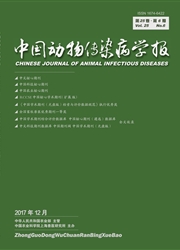

 中文摘要:
中文摘要:
本研究旨在调查甘肃省玛曲地区牦牛双芽巴贝斯虫病的流行情况并对可能影响其感染的因素进行深入分析。本试验采用酶联免疫吸附试验(enzyme-linked immunosorbent assay,ELISA)方法对该地区的600份牦牛血清样品进行检测,随后运用流行病学、统计学方法对可能影响牦牛双芽巴贝斯虫感染的因素进行全面分析。调查结果表明,该地区牦牛双芽巴贝斯虫抗体阳性率为22.33%,其中性别和采样季节两个因素对牦牛双芽巴贝斯虫感染的影响均不具备显著统计学意义(P〉0.05),而年龄因素对牦牛双芽巴贝斯虫感染的影响具有显著统计学意义(P〈0.05)。综上所述,甘肃省玛曲地区牦牛双芽巴贝斯虫普遍流行并具有较高的感染率,存在向牧区其他放养牦牛及野生动物传播该病的风险隐患。因此相关部门应针对该地区牦牛双芽巴贝斯虫感染情况采取有效的预防、控制措施,严防该病扩散蔓延,保证当地及周边藏民牦牛养殖的经济效益。
 英文摘要:
英文摘要:
The present study aimed to investigate the seroprevalence of Babesia bigemina infection and analyse the relevant factors in yaks in Maqu area,Gansu province. ELISA methed was used to detect antibodies against Babesia bigemina in 600 yak serum samples. Then, epidemiological and statistical metheds were used to analyze the risk factors. The survey results showed that the overall positive rate was 22.33%. In addition, sampling season and gender of yaks were not significantly different for Babesia bigemina infection(P〉0.05) except the age of yaks. In conclusion, the prevalence of Babesia bigemina infection in yaks in Maqu area was high, which posted the potential risks of transmitting it to other wild animals. Therefore,effective strategies and measures should be taken to control and prevent Babesia bigemina infection in yaks in this region for economic benefit for the local and surrounding Tibetans.
 同期刊论文项目
同期刊论文项目
 同项目期刊论文
同项目期刊论文
 期刊信息
期刊信息
